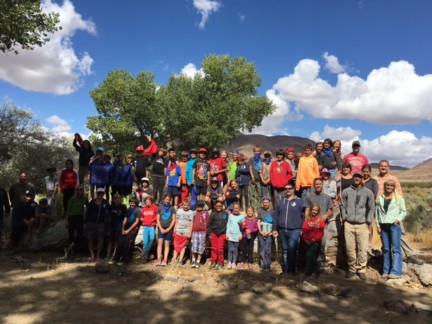September was filled with Constitution Day, horseback riding and overnight fieldwork! Thank you to all of our wonderful parent volunteers who helped our fieldwork go smoothly. Without you, we would never have the experience of outdoor classrooms/field work. Thank You!
As we close up our first case study, the students are assimilating all they learned about the thirteen colonies and the three colonial regions. They now know interesting facts as to who and why colonies were founded, what kind of land/resources/trade occurred, and religious and political background of the thirteen colonies. They are in the process of creating a five paragraph informational pieces. This is a big assignment and they are putting forth great effort to complete it. The above explains how we embed our ELA into our expedition through writing, reading and poetry. This informative piece includes structures of the standards such as: write an informative text to examine a topic and convey ideas and information clearly, introduce a topic clearly and group related information in paragraphs and sections and use precise language and domain-specific vocabulary to inform about or explain the topic. In addition, the students made inferences about colonial life supported by details from a text and determinations about the meaning of content words or phrases in an informational text in a close read of colonial times inventory.
“Taxation without representation is tyranny”
These words are usually attributed to James Otis, a leader in the independence movement in Boston as trouble rose with England in the 1760s and 1770s. They spread far and wide in the colonies as calls for independence grew louder.
Our second case study titled “The Boston Tea Party” will be about the many Acts and Laws that were imposed on the colonist and their reactions/consequences. We will create a class chant about the Sugar, Navigation, Quartering, Townshend and Stamp Act. We plan to scour our reading resources about the Revolutionary War and each student will chose an article that appeals to them. Then we will create our own Found Poems from these readings. This process is a great way to perform a Getting the Gist protocol to understand the complex text that we read. A key individual that we will focus on is Paul Revere and that he is most famous for alerting the Colonial militia to the approach of British forces before the battles of Lexington and Concord, as dramatized in Henry Wadsworth Longfellow’s poem, “Paul Revere’s Ride”. The students have danced weekly and have a few colonial minuets memorized. We are hard at work getting our final product together for celebration of learning.
Math
4th graders are coming up on their first big assessment as they finish unit one. They have a great grasp on multiplies, factors, composite and prime numbers. We will close unit one with a mini unit about making comparisons with measurement such as height, weight, liquids and distances. Then in unit two, the students will continue to build multiplicative reasoning as they work with multi-digit multiplication and beginning division. We will learn with building arrays and ratio tables. The students will create the great wall of base ten as they investigate place value patterns.
5th graders are currently wrapping up their first unit of study on multiplication strategies. By understanding the doubling and halving, 5 is half of 10, partial products, and over strategies, students can decipher which strategy is most appropriate for them to use in different situations. Students can apply this knowledge of strategies to their fluency with volume. In this rst unit, students use the study of volume to review and extend a host of skills and concepts related to multiplication. We have taken a deep look at the associative and commutative properties of multiplication as students use expressions with parentheses to represent different rectangular prism. Over the course of the unit, students are introduced to four WorkPlace games to build multiplicative thinking—a key component for success with division and fractions throughout the rest of the year. Make sure to review the anchor chart with your child and ask them to explain to you how to use each one! Our Problem of the Week this past week really stumped our students and caused them to use their grappling skills. Students should put you to the test- give it a try!
Goal Setting Conferences
Our goal setting conferences are just around the corner. The students have their packet to fill out with their parents. Please sit down with your child and go over the brainstorming packet and set some goals. It is most helpful to come to goal setting conferences with goals already in mind! One of the most powerful learning tools for children is modeling. This year, we are asking our parents to become goal setting models and set their own parent support goal during our goal setting conferences. Please consider a goal that will support your child in the academic or character realm. It can, but does not need to be, directly linked to your child’s goals. We just ask that it be an attainable goal that your child can see you actively working towards.
Thanks again to all our wonderful parents!
Happy Fall,
Julie and Lynn

